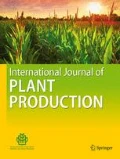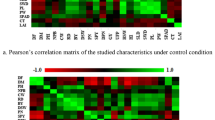Abstract
Quinoa is gaining importance globally owing to its nutritional quality and its adaptability under variety of conditions. However, limited information is available on the impact of planting techniques on growth, morphology, and yield and biomass accumulation under irrigation conditions. To the date, no ideal planting technique (sowing method) has been reported for the flat irrigated land for better adjustment of quinoa in a crop rotation. To test the hypothesis, a two-year field study (2013–14 and 2014–15) was carried out at University of Agriculture, Faisalabad, Pakistan. The experiment comprised of four planting technique bed sowing (BS), ridge sowing (RS), flat line sowing (FLS), and sowing in standing water (SSW) in main plots, and two quinoa accession (A7 and A9) in subplots. The results showed that BS method improved the morphological attributes viz. stem thickness, main panicle, main panicle, thousand grain weight, grain yield, and harvest index as compared to SSW. Regarding the quinoa accessions, A9 performed better than A7 for morphology, biomass, and yield. Panicle number per plant was positively correlated with harvest index and main panicle weight in 2013–14, while 1000-grain weight and harvest index had a stronger correlation during 2014–15. The average and maximum biomass production rate of A7 in BS plants were relatively higher than other sowing techniques either for A9 or A7. Our data suggest that the BS method is a relatively better planting technique and A9 quinoa accession is a suitable genotype to obtain a high targeted grain yield under irrigated conditions.







Similar content being viewed by others
References
Abdullah, G., Hassan, I. A., Khan, S. A., & Ali, H. (2008). Impact of planting methods and herbicides on weed biomass and some agronomic traits of maize. Pakistan Journal of weed science Research,14, 121–130.
Ali, H., Afzal, N. M., & Muhammad, D. (2009). Effect of sowing dates and plant spacing on growth and dry matter partitioning in cotton (Gossypium hirsutum L.). Pakistan Journal of Botany,41, 2145–2155.
Ali, S., Hafeez, A., Ma, X., Tung, S. A., Liu, A., Chattha, M. S., et al. (2019). Equal potassium-nitrogen ratio regulated the nitrogen metabolism and yield of high-density late-planted cotton (Gossypium hirsutum L.) in Yangtze River valley of China. Industrial Crops and Products,129, 231–241.
Andrews, D. (2017). Race, status, and biodiversity: the social climbing of quinoa. Culture, Agriculture, Food and Environment,39, 15–24.
Arnon, D. I. (1949). Copper enzymes in isolated chloroplasts, polyphenoxidase in Beta vulgaris L. Plant Physiology,24, 1–15.
Awadalla, A., & Morsy, A. S. M. (2017). Influence of planting dates and nitrogen fertilization on the performance of quinoa genotypes under Toshka Conditions. Egyptian Journal of Agronomy,39, 27–40.
Aguilar, P. C., & Jacobsen, S. E. (2003). Cultivation of quinoa on the Peruvian Altiplano. Food Reviews International, 19(1–2), 31–41.
Ascheri, J. L. R., Spehar, C. R., & Nascimento, R. E. (2002). Comparative chemical characterization of instantaneous flours by extrusion-cooking from quinoa (Chenopodium quinoa Willd.), corn and rice. Alimentaria, 331, 89–92.
Bahlgerdi, M., Aroiee, H., & Azizi, M. (2014). The study of plant density and planting methods on some growth characteristics, seed and oil yield of medicinal pumpkin. American Journal of Life Science,2, 319–324.
Bakht, J., Ahmad, S., Tariq, A., & Shafi, M. H. (2006). Response of maize to planting methods and fertilizer nitrogen. Journal of Agriculture and Biological Science,1, 8–14.
Bakht, J., Shafi, M., Rehman, H., Uddin, R., & Anwar, S. (2011). Effect of planting methods on growth, phenology and yield of maize varieties. Pakistan Journal of Botany,43, 1629–1633.
Bange, M. P., & Milroy, S. P. (2000). Timing of crop maturity in cotton: Impact of dry matter production and partitioning. Field Crops Research,2, 143–155.
Belachew, T., & Abera, Y. (2010). Response of maize (Zea mays L.) to tied ridges and planting methods at Goro, Southeastern Ethiopia. American Euroasian Journal of Agronomy,3, 21–24.
Bertero, H. D., Vega, D. L., Correa, G., Jacobsen, S. E., & Mujica, A. (2004). Genotype and genotype-by-environment interaction effects for grain yield and grain size of quinoa (Chenopodium quinoa Willd.) as revealed by pattern analysis of international multi-environment trials. Field Crops Research,89, 299–318.
Cheng-Yu, W., Xing-Long, D., & Yu-Hua, S. (2012). Effects of leaf area index on photosynthesis and yield of winter wheat after anthesis. Acta Metallurgica Sinica,18, 27–34.
Curti, R. N., Andrade, A. J., Bramardi, S., Vela-squez, B., & Daniel, B. H. (2012). Ecogeographic structure of phenotypic diversity in cultivated populations of quinoa from Northwest, Argentina. Annual Applied Biology,160, 114–125.
Dong, C., Fu, Y., Liu, G., & Liu, H. (2014). Growth, photosynthetic characteristics, antioxidant capacity and biomass yield and quality of wheat (Triticum aestivum L.) exposed to LED light sources with different spectra combinations. Journal of Agronomy and Crop Science,200, 219–230.
Eisa, S., Hussin, S., Geissler, N., & Koyro, H. W. (2012). Effect of NaCl salinity on water relations, photosynthesis and chemical composition of Quinoa (Chenopodium quinoa Willd.) as a potential cash crop halophyte. Austrian Journal of Crop Science,6, 357–368.
El-Youssfi, L., Choukr-Allah, R., Zaafrani, M., Mediouni, T., Ba-Samba, M., & Hirich, A. (2012). Effect of domestic treated wastewater use on three varieties of Quinoa (Chenopodium quinoa) under semiarid conditions. World Academy Science Engineering and Technology,68, 306–309.
FAO (Food and Agriculture organization) (2013). Home-international year of quinoa 2013. http://www.fao.org/quinoa-2013/en/. Accessed 26 Dec 2013.
Fritischi, F. B., Bruce, A. R., Travis, R. L., Rains, D. W., & Hutmacher, R. B. (2003). Response of irrigated acala and pima cotton to nitrogen fertilizeration: growth, dry matter partitioning and yield. Agronomy Journal,95, 133–146.
Geerts, S., Raes, D., Garcia, M., Taboada, C., Miranda, R., Cusicanqui, J., et al. (2009). Modelling the potential for closing quinoa yield gaps under varying water availability in the Bolivian Altiplano. Agriculture and Water Management,96, 1652–1658.
González, J. A., Gallardo, M., Hilal, M., Rosa, M., & Prado, F. E. (2009). Physiological responses of quinoa (Chenopodium quinoa Willd.) to drought and waterlogging stresses: dry matter partitioning. Botanical Studies,50, 35–42.
González, L., & González-Vilar, M. (2001). Determination of relative water content. In M. J. R. Reigosa (Ed.), Handbook of plant ecophysiology techniques. Dordrecht: Springer. https://doi.org/10.1007/0-306-48057-3_14.
Gonzalez, J. A., Konishi, Y., Bruno, M., Valoy, M. A., & Prado, F. E. (2012). Inter relationships among seed yield, total protein and amino acid composition of ten quinoa (Chenopodium quinoa) cultivars from two different agro-ecological regions. Journal of Science Food and Agriculture,92, 1222–1229.
Graf, B. L., Rojas-Silva, P., Rojo, L. E., Delatorre-Herrera, J., Balde, M. E., & Raskin, I. (2015). Innovations in health value and functional food development of quinoa (Chenopodium quinoa Willd.). Comprehensive Reviews in Food Sciience and Food Safety,14, 431–445.
Gupta, G., Hooda, V. S., Thakral, S. K., Kumar, N., Kumar, V., & Dwivedi, A. (2017). Effect of different crop establishment methods and nitrogen levels on growth attributes, dry matter partitioning and radiation characteristics of wheat (Triticum aestivum L.). International Journal of Pure and Applied Bioscience,5, 617–623.
Hafeez, A., Ali, S., Ma, X., Tung, S. A., Shah, A. N., Liu, A., et al. (2018). Potassium to nitrogen ratio favors photosynthesis in late-planted cotton at high planting density. Industrial Crops and Products,124, 369–381.
Hirich, A., Choukr-Allah, R., & Jacobsen, S. E. (2013). The combined effect of deficit irrigation by treated wastewater and organic amendment on quinoa (Chenopodium quinoa Willd.) productivity. Desalination Water Treatment,52, 1–6.
Hirich, A., Choukr-Allah, R., & Jacobsen, S. E. (2014). Quinoa in Morocco-effect of sowing dates on development and yield. Journal of Agronomy and Crop Science,200, 371–377.
Hassan, M. U., Chattha, M. U., Chattha, M. B., Mahmood, A., & Sahi, S. T. (2019). Chemical composition and methane yield of sorghum as influenced by planting methods and cultivars. The Journal of Animal and Plant Sciences, 29(1), 251–259.
Hodge, A. (2004). The plastic plant: root responses to heterogeneous supplies of nutrients. New Physiologist,162, 9–24.
Hu, W., Coomer, T. D., Loka, D. A., Oosterhuis, D. M., & Zhou, Z. (2017). Potassium deficiency affects the carbon-nitrogen balance in cotton leaves. Plant Physiology and Biochemistry,115, 408–417.
Jancurová, M., Minarovičová, L., & Dandár, A. (2009). Quinoa—a review. Czech Journal of Food Science,27, 71–79.
Kaya, M. D., Okcub, G., Ataka, M., Cikilic, Y., & Kolsaricia, O. (2006). Seed treatments to overcome salt and drought stress during germination in sunflower (Helianthus annus L). European Journal of Agronomy,24, 291–295.
Kumar, M., Yadav, A., Sheoran, P., & Singh, S. (2011). Effect of sowing methods and nitrogen management strategies on yield and nutrient uptake of wheat (Triticum aestivum L.). Ecology and Environmental Concern,17, 665–668.
Loew, A., Van-Bodegom, P. M., Widlowski, J. L., Otto, J., Quaife, T., Pinty, B., et al. (2013). Do we (need to) care about canopy radiation schemes in DGVMs? An evaluation and assessment study. Biogeo Sciences Discussions,10, 16551–16613.
Martinez, E. A., Fuentes, F., & Bazile, D. (2015). History of quinoa: Its origin, domestication, diversification and cultivation with particular reference to the Chilean context. In K. Murphy & J. Matanguihan (Eds.), Quinoa: Improvement and sustainable production (pp. 19–24). Hoboken: Wiley.
Mbatha, T. P., & Modi, A. T. (2010). Response of local mustard germplasm to water stress. African Journal of Plant and Soil,27, 328–330.
Nasir, M., & Akbar, H. (2000). Effect of different plant populations on yield and yield component of different maize varieties. M.Sc. (Hons) Thesis, Department of Agronomy, KPK Agriculture University, Peshawar, Pakistan.
Ortega, A. L., Mir, E. V., & Rangel, E. E. (2008). Nitrogen management and wheat genotype performance in a planting system on narrow raised beds. Cereal Research Communication,36, 343–352.
Rahman, H. R., Malik, S. A., Saleem, M., & Hussain, F. (2007). Evaluation of seed physical traits in relation to heat tolerance in upland cotton. Pakistan Journal of Botany,39, 475–483.
Rasheed, M., Mahmood, T., Nazir, M. S., Bhutta, W. A., & Ghaffar, A. (2004). Nutrient efficiency and economics of hybrid maize under different planting methods and nutrient levels. International Journal of Agriculture and Biology,6, 922–925.
Rauf, S., & Sadaqat, H. A. (2007). Effects of varied water regimes on root length, dry matter partitioning and endogenous plant growth regulators in sunflower (Helianthus annuus L.). Journal of Plant Interaction,2, 41–51.
Rauf, S., & Sadaqat, H. A. (2008). Effect of osmotic adjustment on root length and dry matter partitioning in sunflower (Helianthus annuus L.) under drought stress. Acta Agricultural Science Section B Soil and Plant Science,58, 252–260.
Schenk, H. J. (2005). Vertical vegetation structure below ground: Scaling from root to globe. Progress in Botany,66, 341–373.
Schulte, E. G., Kaula, K. H. P., Kruseb, M., & Aufhammer, W. (2005). Yield and nitrogen utilization efficiency of the pseudo-cereals amaranth, quinoa, and buckwheat under differing nitrogen fertilization. European Journal of Agronomy,22, 95–100.
Shams, A. S. (2012). Response of quinoa to nitrogen fertilizer rates under sandy soil conditions. In 13th international conference of Agron Faculty of Agriculture, Benha University, Egypt, 9–10 September, pp. 195–205.
Valencia-Chamorro, S. A. (2003). Quinoa. In B. Caballero (Ed.), Encyclopedia of Food Science and Nutrition (pp. 895–4902). Masterdam: Academic Press.
Wang, F., Xuqing, W., & Sayre, K. (2004). Comparison of conventional, flood irrigated, flat planting with furrow irrigated, raised bed planting for winter wheat in China. Field Crops Research,87, 35–42.
Warren, J. M., Hanson, P. J., Iversen, C. M., Kumar, J., Walker, A. P., & Wullschleger, S. D. (2015). Root structural and functional dynamics in terrestrial biosphere models-evaluation and recommendations. New Physiologist,205, 59–78.
Yang, G., Tang, H., Nie, Y., & Zhang, X. (2011). Response of cotton growth, yield, and biomass to nitrogen split application ratio. European Journal of Agronomy,35, 164–170.
Acknowledgements
We are highly thankful to a native English speaker from USA, Mr. Jerried (College of fisheries, Huazhong Agricultural University, Wuhan, P. R. China) for language editing of the paper. We also appreciates Mr. Mustansar Mubeen (College of Plant Science and Technology, Huazhong Agricultural University, Wuhan, P. R. China) for technical support regarding data analysis and language polishing of this paper.
Author information
Authors and Affiliations
Corresponding author
Ethics declarations
Conflict of interest
Authors declare that they have no any conflict of interest for this research.
Rights and permissions
About this article
Cite this article
Ali, S., Chattha, M.U., Hassan, M.U. et al. Growth, Biomass Production, and Yield Potential of Quinoa (Chenopodium quinoa Willd.) as Affected by Planting Techniques Under Irrigated Conditions. Int. J. Plant Prod. 14, 427–441 (2020). https://doi.org/10.1007/s42106-020-00094-5
Received:
Accepted:
Published:
Issue Date:
DOI: https://doi.org/10.1007/s42106-020-00094-5




